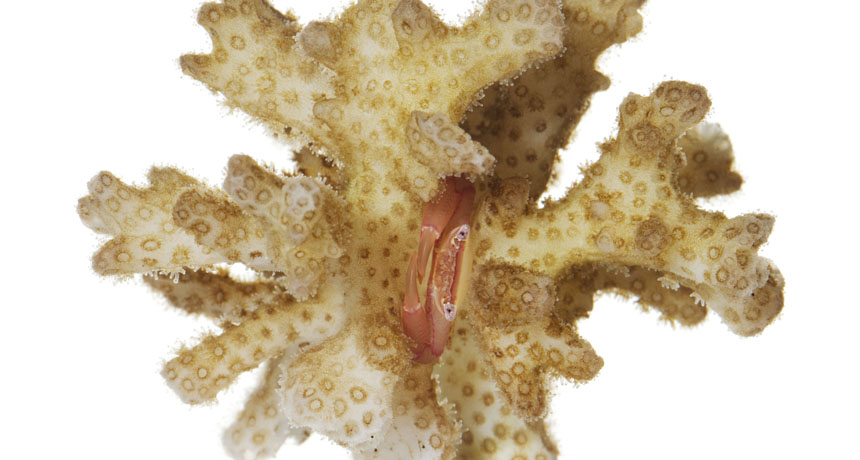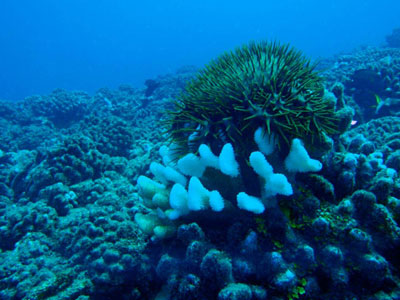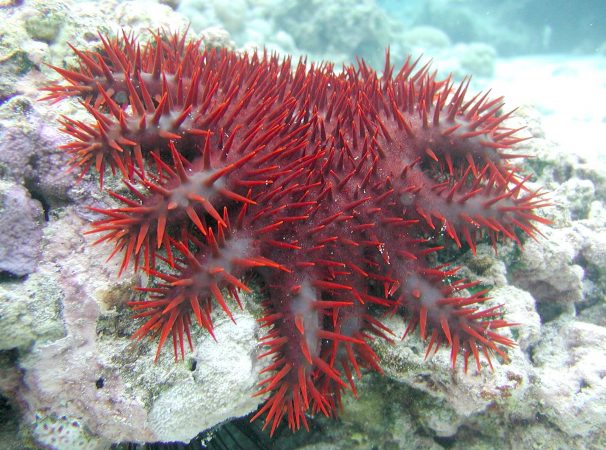Crabs play defense, save corals
Some small crustaceans guard coral from predatory starfish

Crabs, like the tiny one at center, nestle within the branches of some stony corals. These crabs can protect their hosts from killer snails and starfish.
David Liittschwager
Some small but feisty crabs live among the branches of stony coral. And that’s a good thing — at least for the corals. Although tiny, the crabs can fend off coral-eating starfish up to 18 times their size, a new study finds.
In 2008, for instance, an outbreak of crown-of-thorns starfish overran corals in Mo’orea, an island in French Polynesia. The large, spiky starfish (or sea stars) quickly devastated the local coral reefs in this part of the southern Pacific Ocean. But corals defended by one species of guard-crab survived. The new research shows why.
“The guard-crabs are tough,” says C. Seabird McKeon. When their corals are under attack, the crabs become quite defensive. “They pinch off tube feet and spines, and go after the sea star in all of its softest spots,” he notes. McKeon is a marine biologist at the Smithsonian Marine Station in Fort Pierce, Fla. He worked on the new study, which was published September 30 in PeerJ.

In some parts of the Indian and Pacific oceans, Trapezia (Tra-PEE-zee-uh) crabs nestle inside the arms of stony corals. These corals belong to the genus Pocillopora (PAH-sill-ah-POR-ah). Even the largest crabs that hang out in them are only a few centimeters (roughly 1 inch) wide. At night, these mini crabs feed on fats that they harvest from the tips of the tentacles of coral polyps. (Polyps are the living part of corals.) In return for this food, the crabs remove dirt (sediment). They also guard their host coral from predators. Scientists refer to this type of relationship as mutualism. In it, both species benefit from being together.
Typically, a single mating pair of Trapezia crabs — and maybe some young crabs — nestle within the arms of a branching coral. But if the coral colony is big enough, it can host multiple species of crabs. Especially large colonies of these corals may become home to as many as five different species.
During the 2008 Mo’orea outbreak, the local population of crown-of-thorns starfish soared. These starfish can grow to 45 centimeters (18 inches) across. The multi-armed animals dined heavily on the reef, dramatically reducing the area covered by living coral. Prior to the outbreak, 80 percent of the reef had been live coral. Afterward, a measly 3.4 percent was living.
But one species of stony coral took a much smaller hit. McKeon and his colleague Jenna M. Moore were curious how these Pocillopora beat the odds. To test the possible role of Trapezia crabs, they removed one of the largest species of these crabs: T. flavopunctata. They kidnapped the crustaceans from 45 of the coral colonies. Another 45 colonies got to keep their crabs. Over the next few weeks, the researchers compared what happened when corals were visited by starfish.

Unguarded corals lost an average of 22 percent of their tissues, compared with only 2 percent in a crab-guarded colony. The protective effect even extended to other coral species. The starfish tended to leave alone neighboring corals — even when they hosted no guard-crabs
Many undefended corals housed other, smaller species of guard-crabs. Lab experiments showed that these crabs can play their own, different roles in coral defense. Members of one of these crab species, just 4 to 6 millimeters (0.15 to 0.24 inch) across, could fend off small, coral-eating snails. Crabs from a slightly larger species grow 9 to 11 millimeters across. They couldn’t defeat the snails but could protect the coral from Culcita starfish.
When corals have several different-sized species of crabs tucked into their arms, they may stave off several threats. That may help to explain why large Pocillopora colonies tend to survive better than small ones, the researchers say. After all, these corals are big enough to make room for several species at once.
McKeon says his team’s study also points to the value of biodiversity. “The study is a good demonstration of how animals that appear very similar can be playing different ecological roles,” he says. “If we change our starting point to ‘each species is probably doing something different’ instead of ‘these species are all probably doing the same thing,’ it means that our perception of the importance of biodiversity may change.”
Power words
biodiversity (short for biological diversity) The number and variety of organisms found within a geographic region.
coral Marine animals that often produce a hard and stony exoskeleton and tend to live on the exoskeletons of dead corals, called reefs
crustaceans Hard-shelled water-dwelling animals including lobsters, crabs and shrimp.
ecology A branch of biology that deals with the relations of organisms to one another and to their physical surroundings. A scientist who works in this field is called an ecologist.
genus A group of closely related species. For example, the genus Canis — which is Latin for “dog” — includes all domestic breeds of dog and their closest wild relatives, including wolves, coyotes, jackals and dingoes.
marine Having to do with the ocean world or environment.
marine biologist A scientist who studies creatures that live in ocean water, from bacteria and shellfish to kelp and whales.
mutualism A type of symbiosis in which both organisms benefit from the relationship.
predator (adjective: predatory) A creature that preys on other animals for most or all of its food.
reef A ridge of rock, coral or sand. It rises up from the seafloor and may come to just above or just under the water’s surface.
starfish A type of sea creature that is shaped like a star. Starfish, also known as sea stars, are not true fish. They are related to sand dollars, sea urchins and sea cucumbers.
sediment Material (such as stones and sand) deposited by water, wind or glaciers.
species A group of similar organisms capable of producing offspring that can survive and reproduce.







